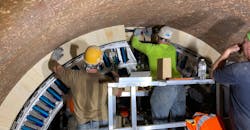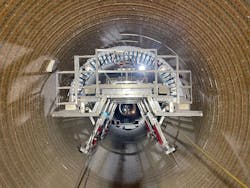Most metalcasting operations managers know that plant safety demands more than personal protective equipment (PPE). Safety requirements only increase when workers are placed in more demanding, high-risk environments. In these operations (as in others, like cement making and pulp and paper processing) it’s necessary to recognize the potential for injuries and downtime when accidents occur, and to calculate the total cost. Additional costs include increased downtime and lost profits, healthcare costs, safety fines and potential liability concerns.
While solutions that provide enhanced safety without sacrificing productivity may be more costly, when looking at the big picture, investing in these solutions up front saves money in the long run. In the United States, avoiding even one major injury in a processing facility pays for customized safety equipment like a bricking machine.
The true cost
The United States Bureau of Labor Statistics found that 2.7% of workers experienced some form of injury on the job in 2021. Rates vary in other nations, with the European Union at 1.4%. However, the true number of work-related injuries is likely much higher, especially when not all countries have the same reporting requirements. Facilities and workers tend not to report minor injuries that do not result in missed days of work — but that does not mean that there is no cost associated with these injuries.
Even the most minor of injuries can result in short-term or long-term pain. Workers in pain simply are not as productive as their healthy counterparts, resulting in hours (if not days) of lost productivity. The most common injuries in processing facilities are material handling injuries on workers’ arms or hands, like cuts, sprains, or strains. Repeated strains or sprains often require medical care. In the United States, a simple strain can cost upwards of $30,000 in direct costs.
These minor injuries may also result in long-term medical costs for employers if they lead to repetitive strain injuries or disabilities. Repetitive strain injuries, such as carpal tunnel syndrome, tendinitis, bursitis and rotator cuff syndrome, are very common. The pain and reduced range of motion from these injuries result cause workers to work slowly or, in some cases, make it so they can no longer work at all.
If a worker is no longer able to work, the facility is, in some countries, responsible for paying disability benefits. According to Liberty Mutual, disabling injuries are the most expensive injuries in the United States. They estimate the total cost of the top 10 disabling workplace injuries is around $59 billion a year.
Processing plant managers looking to avoid repetitive strain injuries should consider what processes are in place for furnace maintenance and rebricking. Many bricking installation methods require high amounts of material handling, whether that’s moving bricks from a wheelbarrow to the installation site or manually holding bricks in place.
Most refractory installation contractors opt to use a bricking machine for safe refractory brick installation. Originally designed to reduce physical strain and safety risks, newer-model machines are fabricated in aircraft-grade aluminum for easy, lightweight set-up and dual arch systems, with pneumatic cylinders to push bricks into place, reducing the risk of injuries from unsupported overhead material.
Originally designed to reduce physical strain and safety risks, newer-model machines are fabricated in aircraft-grade aluminum for easy, lightweight set-up and dual arch systems, with pneumatic cylinders to push bricks into place, reducing the risk of injuries from unsupported overhead material.
One refractory installation contractor found working with a custom-engineered bricking machine was safer than alternative methods, like pogo sticks, because the machine adjusts for the dual brick layer. The bricking machine holds the bricks firmly against the kiln shell and aligns the brickwork to avoid catastrophic failure. This also avoids falling debris and other dangers throughout the bricking process, which reduces the chance of injury.
Calculating safety
Sometimes, though, a plant is not facing just the cost of an injury. In the most severe instances, a safety infringement results in the loss of a life. While a life cannot be assigned a monetary value, research shows that the average cost of a workplace fatality in the United States was $1,340,000 in 2021 — a number that included only direct costs like wage loss, medical expenses, administrative expenses, and employer costs.
Many plant managers are aware of these numbers, but often they do not consider indirect costs, which include training replacement workers, accident investigation, and corrective measures, as well as the negative impact on worker morale after losing a coworker and friend. The direct costs are often doubled or tripled with the untold hidden costs associated with employees’ declining morale and lost trust.
Using safety equipment helps lower the chances of injuries or fatalities in processing plants. However, not all equipment is the same. Facility managers should consider what materials make up safety equipment and the testing that’s been done before purchasing anything. Some industry-leading manufacturers use 6061-T6 aircraft aluminum, which offers the best strength-to-weight ratio available with the same durability of steel at a third of the weight.
Strong materials are important but it’s also necessary to know what safety standards a manufacturer used when testing the equipment, to guarantee the safety of workers. The design and manufacturing process should include both live and simulated tests. While some manufacturers are happy if the initial tests are passed, others continue to analyze and adapt.
Good examples of this are safety cages and personnel tunnels, which protect workers from falling debris. A safety cage made with 6061-T6 aircraft aluminum is strong enough to protect workers from debris up to 140 kilograms (250 pounds) falling from a height of up to 2.4 meters (8 feet), while still being light enough for two people to maneuver.
At a cement plant in Turkey a large amount of coating fell on workers inside the kiln. The workers were using a high-quality safety cage, and it withstood a greater load than its rating as a result. The rigorous safety testing the manufacturer put the cage through ensured workers survived the collapse and escaped without injury.
What’s in a reputation?
Facilities that fail in their safety practices find their reputation taking a big hit. Media coverage, social media channels and other print and online spaces spread information at an unheard-of rate. The impact can go beyond negative news stories too, making it more difficult to find skilled workers who are willing to risk working with a processing facility with a poor safety record.
In Canada and some other countries there are third-party groups that review safety records, documentation, compliance, and other safety requirements, assigning a passing or failing grade that determines the types of jobs these facilities can complete. A major injury or death results in a failing grade.
More work options are not the only way these safety audits can benefit businesses. One refractory installation contractor in Ontario increased recruiting success due to a passing audit result and superior safety practices. Skilled tradesmen sought opportunities as they recognized the importance the company placed on the safety of their employees.
Many places require plants to invest in certain safety equipment. However, investing in these materials is not helpful if no one in the facility uses them. One way to protect against injury and the subsequent costs is to ensure all workers are trained to use the equipment. A strong safety culture is key to preventing accidents and injuries. One way to start promoting a culture of safety is to invest in proper safety equipment.
Jeff Mirisola is vice president of Global Sales & Service of Bricking Solutions Inc.

